Last updated July 2018 | Words and photos by Vietnam Coracle
| 69 comments
This post was last updated 7 years ago. Please check the comments section for possible updates, or read more on my Updates & Accuracy page.
INTRODUCTION | GUIDE | MAP | RELATED POSTS
Over the years, I’ve travelled many, many times between Saigon and Phan Thiet/Mui Ne: by bus, bicycle, car, minivan, coach, but most of the time, by motorbike. I love the ride along the Ocean Road from Vietnam’s biggest city to one of its most popular beach retreats. But there is another way: put your motorbike on the train and let the rails carry your wheels. It’s cheap, easy, fun, fast, efficient and relaxing. Even if you’re not taking your motorbike with you, the train is a much better option than taking one of the buses along Highway 1. Below is my guide to taking the Saigon-Phan Thiet Express train, for passengers and motorbikes.
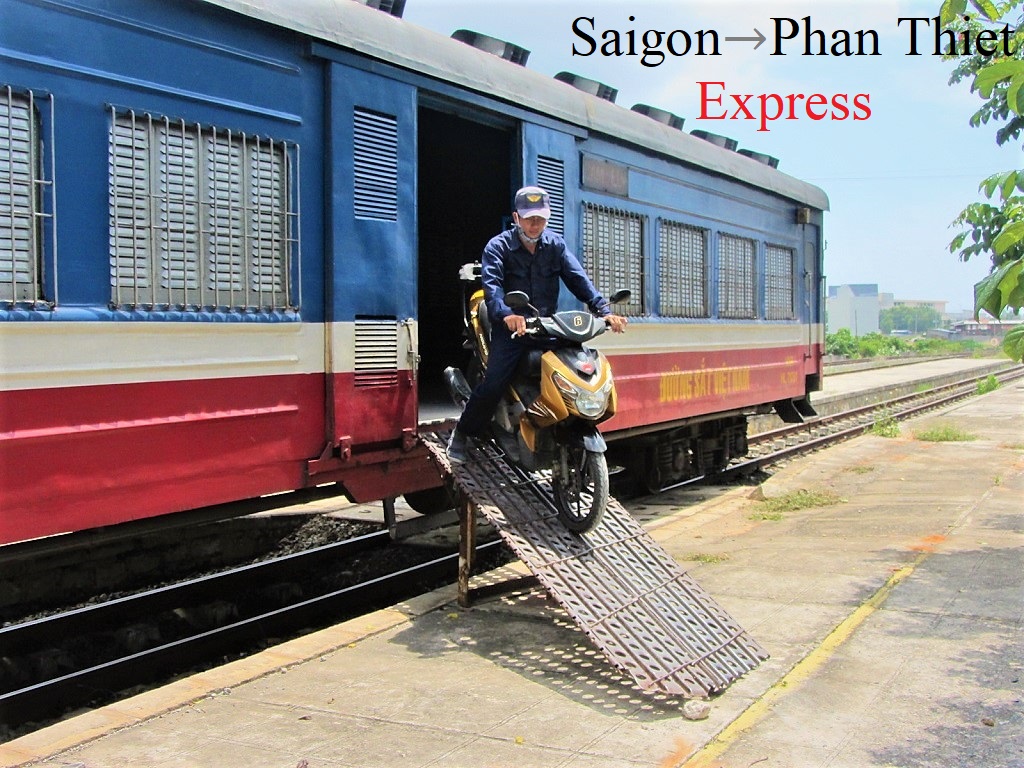
Load your motorbike onto the train, and let the rails carry your wheels
[Back Top]
GUIDE: SAIGON→PHAN THIET EXPRESS
This is a full guide to the daily Saigon-Phan Thiet Express, for passengers and motorbikes. Note that this is one of only a few rail routes in Vietnam that allows passengers to travel on the same train as their motorbike (another being the Hanoi-Lao Cai Express). Below, I’ve organized all the information into separate sections, and plotted the stations, relevant towns, rail and road routes on my map. *Please note: you can support this website by booking train tickets directly from this page: see below for details.

Click an item to read more about it:
- Route Map
- Search & Book Tickets
- Train Operators & Contacts
- Train Times & Schedules
- Ticket Prices & Booking
- Sending your Motorbike
- Departure & Arrival Stations
- The Trains
- The Journey
MAP:
Saigon to Phan Thiet Rail & Road Routes
- Black Line: train route
- Red Line: road route (via Highway 1)
- Blue Line: road route (via the Ocean Road)
SEARCH & BOOK TICKETS:
*Please support Vietnam Coracle: you can search train times, prices, and make bookings directly from this page by using the Baolau.com search boxes & links throughout this guide. If you make a booking, I receive a small commission. All my earnings go straight back into this website. Thank you.
Train Operators & Contacts:
The Saigon-Phan Thiet express service is part of the state-run Vietnam Railways (VNR) network. Vietnam Railways have a decent English-language version of their website (www.vr.com.vn/en) where you can find up to date information. Or go in person directly to Saigon or Phan Thiet train stations, where some staff speak some English. Alternatively, check current train schedules, prices, information, and make reservations through Baolau.com.
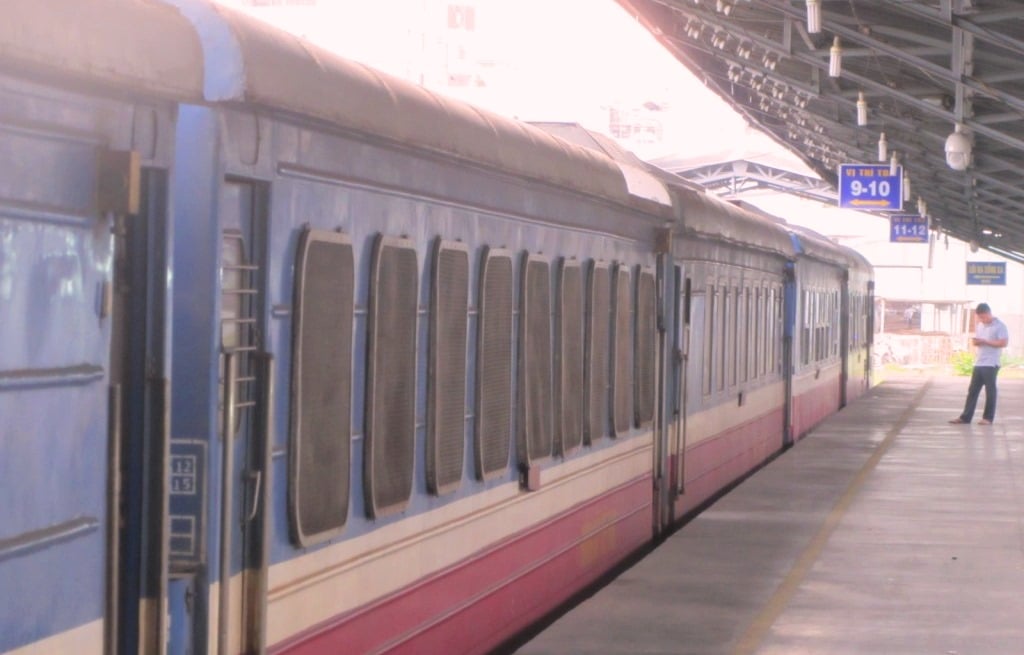
The Saigon-Phan Thiet express train, about to depart from Saigon station
Train Times & Schedules:
There is one non-stop direct service in each direction every day. Although times are subject to minor changes, the general schedule has been the same for years. Journey time is roughly 4 hours. I’ve taken this train many times and never experienced any significant delays. For current schedules, prices, and bookings check Baolau.com and Vietnam Railways:
SAIGON→PHAN THIET:
- Train SPT2: Depart: 6.40am→Arrive: 10.28am (non-stop, daily)
PHAN THIET→SAGION:
- Train SPT1: Depart: 1.05pm→Arrive: 5.03pm (non-stop, daily)
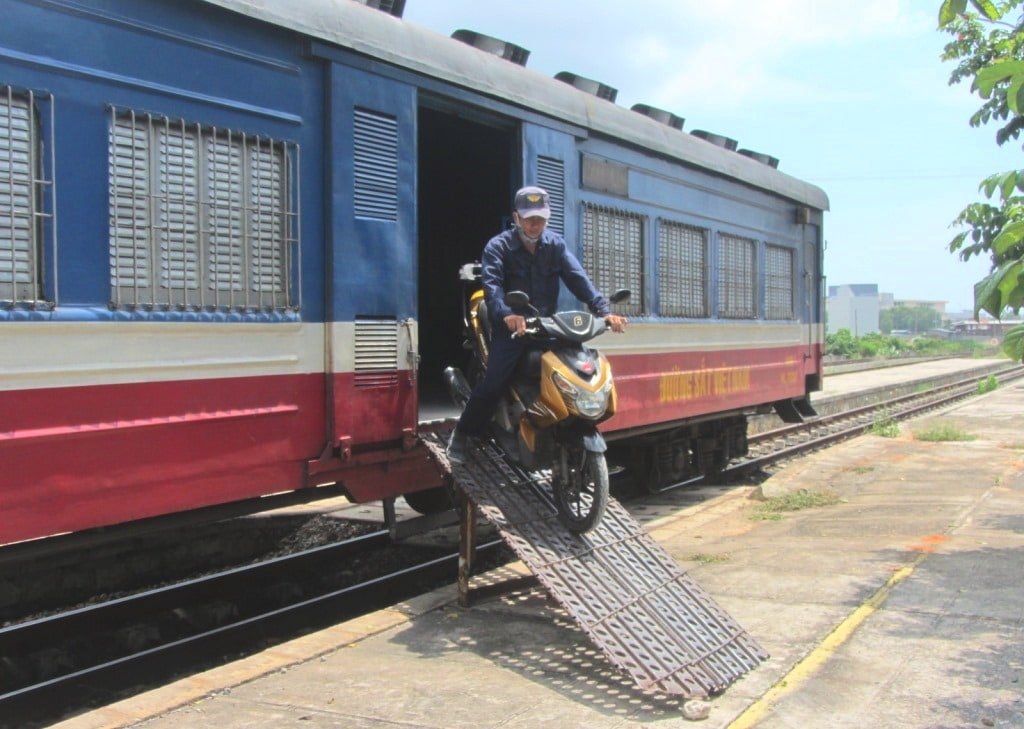
Vietnam Railways staff roll Stavros off the train at Phan Thiet station
Ticket Prices & Booking:
Although ticket prices vary a little depending on whom and where you book, the discrepancies are fairly minimal, and the price list below is accurate at the time of writing (May 2018). Check current ticket prices and make bookings online at Baolau.com and Viet Nam Railways. It’s a simple process, and you will be issued an e-ticket by email. Tickets can also be purchased in person at Saigon or Phan Thiet stations, or through many hotels and travel agents across Vietnam. However, tickets for motorbikes must be purchased in person at the station (or, in some cases, through hotels and travel agencies) – see below for details. If travelling on a weekend or public holiday, it’s advisable to book tickets at least a day in advance, as trains can be full at these times. During the week, you should be able to get a ticket on the day of departure, although it’s still best to book in advance to avoid disappointment. All the following prices are one-way:

- Soft seat: 145,000vnd
- Soft seat premium: 160,00,000vnd (a more modern coach)
- Soft sleeper (a bunk in 4-berth compartment): 210,000vnd (top or bottom bunk)
- Motorbike: 170,000vnd (possible extra charge for motorbikes over 125cc)
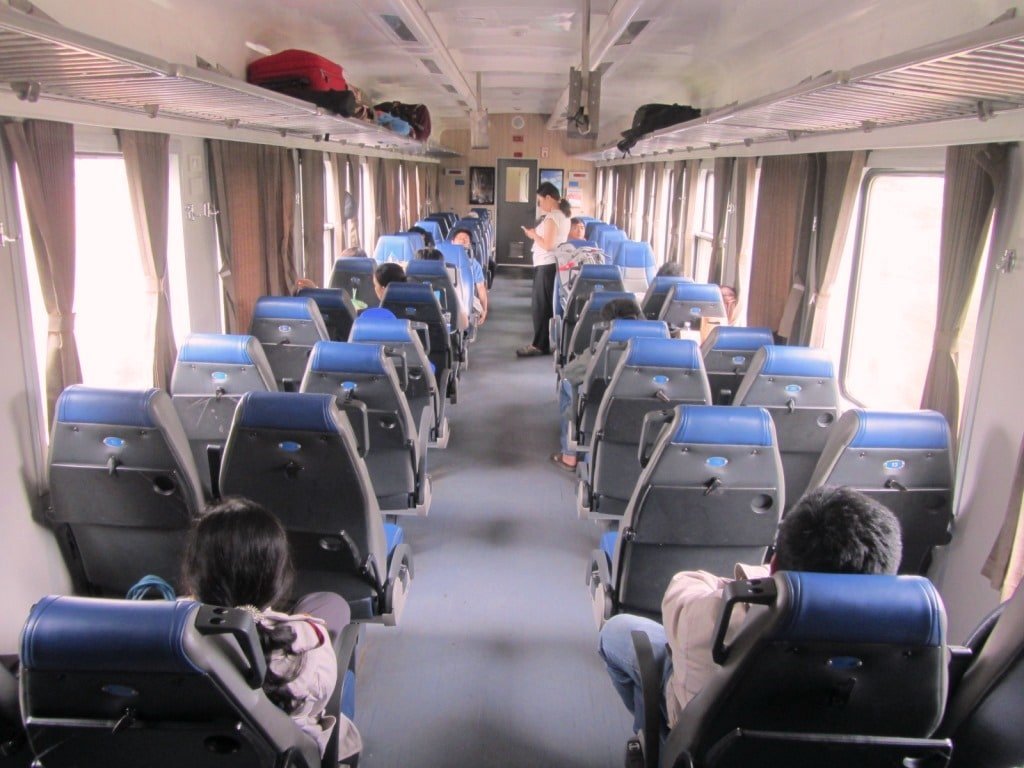
Soft, reclinable seats, air-con and decent bathrooms in all carriages
Sending your Motorbike:
Unlike most other train journeys in Vietnam (read more about that here), the Saigon-Phan Thiet express service allows passengers and their motorbikes to travel on the same train. Buy your motorbike ticket directly at Saigon or Phan Thiet train stations; either a day or two prior to departure (advisable) or on the day of travel. This should be a fairly simple and painless process for most travellers, although in Saigon it may require a bit of queuing and patience. (If booking your train tickets through a hotel or travel agency, it’s worth asking if they can also book your motorbike ticket.) Passengers with motorbikes are required to be at the station 30-40 minutes before departure. In order to put your motorbike on the train, you must drive through the station gates and onto the platform. At Saigon station, the entrance is to the left of the main station building, signposted in Vietnamese as cửa đi – đón khách tàu Phan Thiết. At Phan Thiết station, the entrance is also on the left of the station building. Ride your motorbike along the platform (which is great fun, although station staff are starting to clamp down on this practice) to the back end of the train. Here you’ll find a few other motorbikes waiting to be loaded onto the freight car. Show your ticket to the handling staff (there’s sometimes a 10,000vnđ ‘handling’ fee) and they will give you a paper receipt for your motorbike: do not lose this. After leaving your motorbike with the staff, make your way to the passenger carriages and find your seat on the train; when you arrive at your destination, stroll along the platform to the freight car, show your receipt, and drive off.
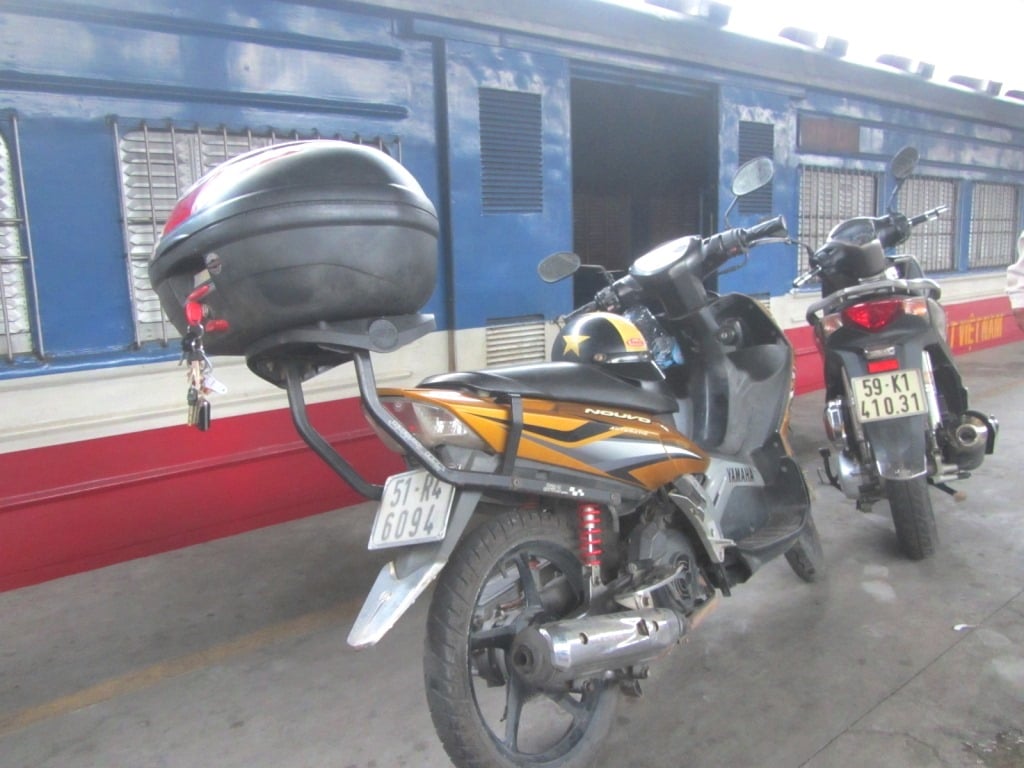
My motorbike, Stavros, waiting to be loaded onto the freight car
Departure & Arrival Stations:
The Saigon-Phan Thiet train is an express service: there are no station stops between the the departure and destination stations. However, some trains occasionally make brief stops at Bien Hoa (45 minutes from Saigon) and Binh Thuan (10 minutes from Phan Thiet). Saigon and Phan Thiet stations could hardly be more different: the former is the busy terminus for all southbound trains; whereas the latter is a quiet, almost rural, station at the end of a spur line.
SAIGON TRAIN STATION: (Ga Sài Gòn); Address: 01 Nguyen Thong Street, District 3 [MAP]: In the busy back-streets of District 3, Saigon Station is a boring-looking terminus (although the old steam train at the entrance is impressive), but it functions pretty well. Passengers can enter the main building via several entrances; show your ticket at the gate in the waiting hall, and board the train. (See above for motorbike boarding). There are several cafes, shops, and fast food outlets inside the station building. A steady flow of taxis wait outside the front entrance.

PHAN THIET TRAIN STATION: (Ga Phan Thiết); Address: Phong Nam, Phan Thiet City [MAP]: A few kilometres northwest of the centre of town, Phan Thiet Station has a pleasantly provincial feel to it. It’s rarely chaotic and very easy to navigate. There’s generally only one train in the station, so there’s no chance of boarding the wrong one. Some light snacks are available from the shop. Taxis meet the trains when they arrive.
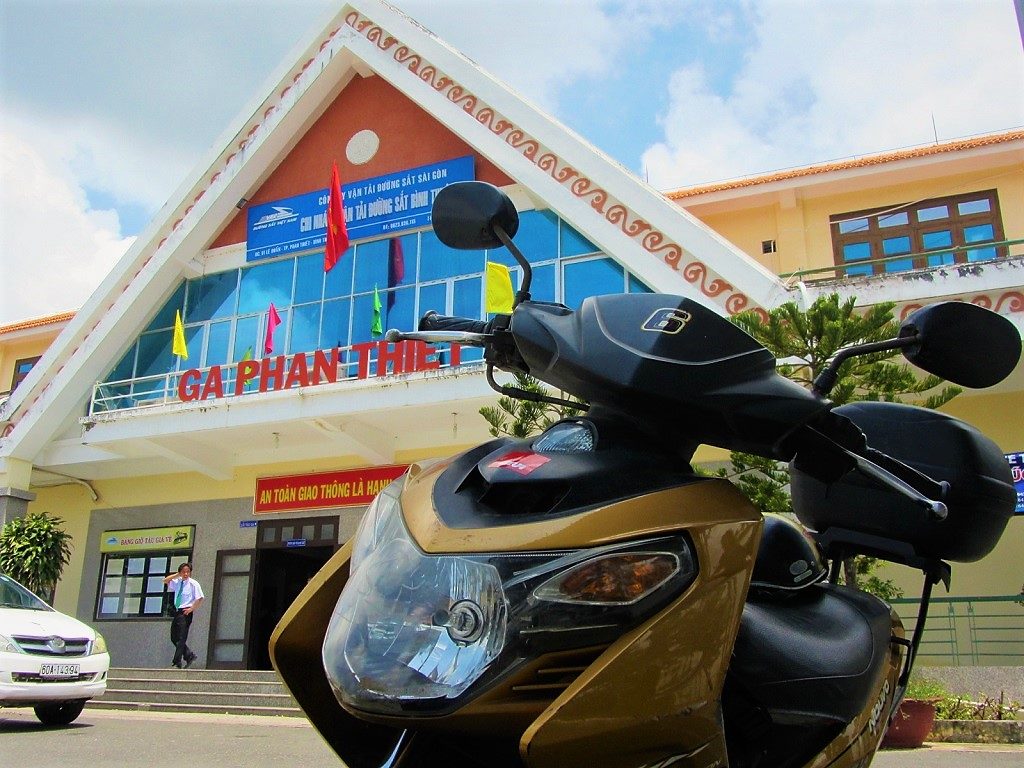
My motorbike outside Phan Thiet train station, a quiet, almost rural terminus
The Trains:
In the last couple of years, most of the carriages on the Saigon-Phan Thiet Express have been upgraded or, in some cases, are essentially brand new. All carriages are air-conditioned (in fact, it’s a good idea to bring a sweater) and all seats and sleeping berths are soft and comfy (chairs have reclinable backs). There are perfectly adequate toilets and wash basins in every carriage, and the general standard of cleanliness is pretty good. Passengers used to receive a complimentary snack bag containing a bottle of water and rice crackers, the best part of which was the design of the packaging – a good souvenir from Vietnam Railways. However, that endearing little tradition seems to have faded; instead, passengers are presented with a miniature bottle of water. Other endearing traditions, however, endure. For example, about midway through the journey, a steaming trolley of fresh, piping hot sweet corn is wheeled up and down the aisles; so too are freshly boiled chicken and duck eggs. Wonderful. Can you imagine that on a European train?
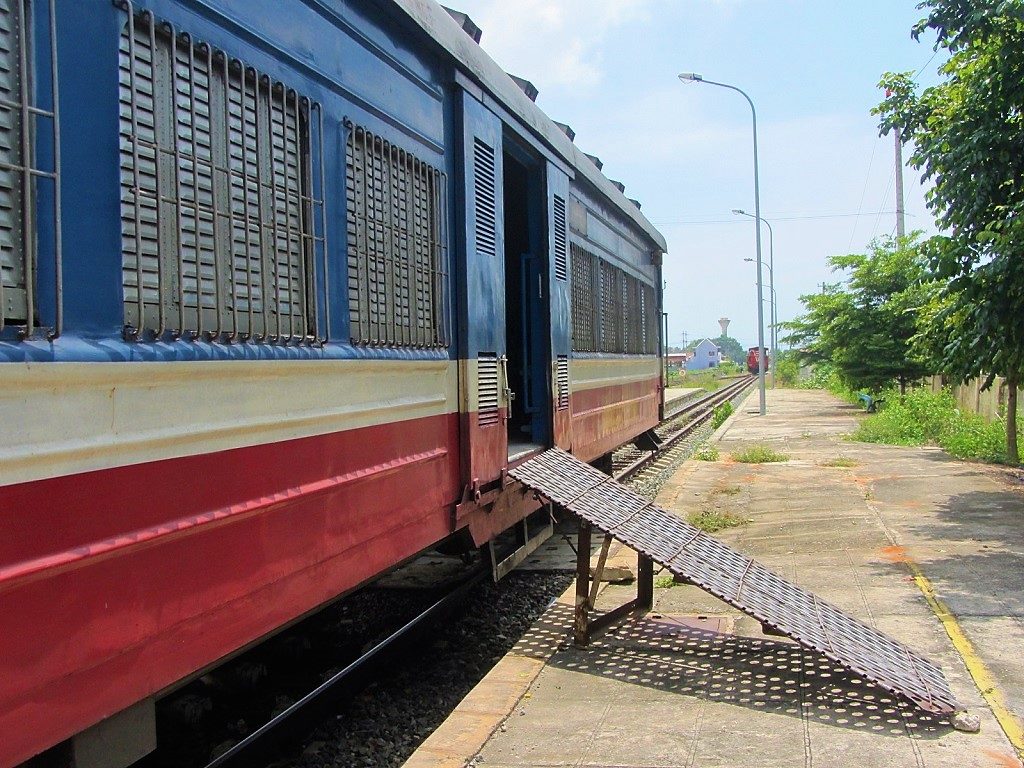
In the last couple of years, most of the carriages have been upgraded on the Saigon-Phan Thiet train
A dining car, towards the rear of the train, sports wooden chairs, large windows, and a surprisingly decent selection of Vietnamese noodles, stir-fries, soups and drinks, all of which are reasonably priced and pretty tasty. Regardless of quality, there’s always something romantic about sitting in the dining carriage of a train, with a bite to eat, a coffee, a book, and watching the scenery pass by. And another Vietnamese train tradition: the second half of the journey often sees Vietnam Railways staff relax with a crate of beer and a pile of freshly cooked seafood (from the fish markets of Phan Thiet, no doubt). As the beer flows and the food is consumed, the volume rises and you’d be forgiven for thinking you were in a raucous Saigon eatery on a Friday night.

The dining car serves pretty good food and drink
The Journey:
After rolling out of Saigon station, the train rattles through the city. The driver leans on the horn as the train passes through crowded local neighbourhoods, across busy intersections – the traffic piled up either side of the junction – over the Saigon River and out into the dusty suburbs. Life continues just metres from the tracks, offering a fascinating cross-section of the city: markets, cafes, offices, temples, homes, schools. I used to live in a house near the railway, and each time I heard the horn and rattling carriages, I longed to be on the train.
Beyond the industrial armpit of Bien Hoa City, the train makes its way east through an extremely lush landscape of crop fields, fruit orchards, and plantations: banana, coffee, jackfruit, cassava, cashew, mango, rubber, sugar cane, corn and rice all grow within a few feet of the train. Deeper into the journey, green hills begin to rise from the folds of the rolling fields. It’s tropical, exotic, exciting – everything a good train journey should be.
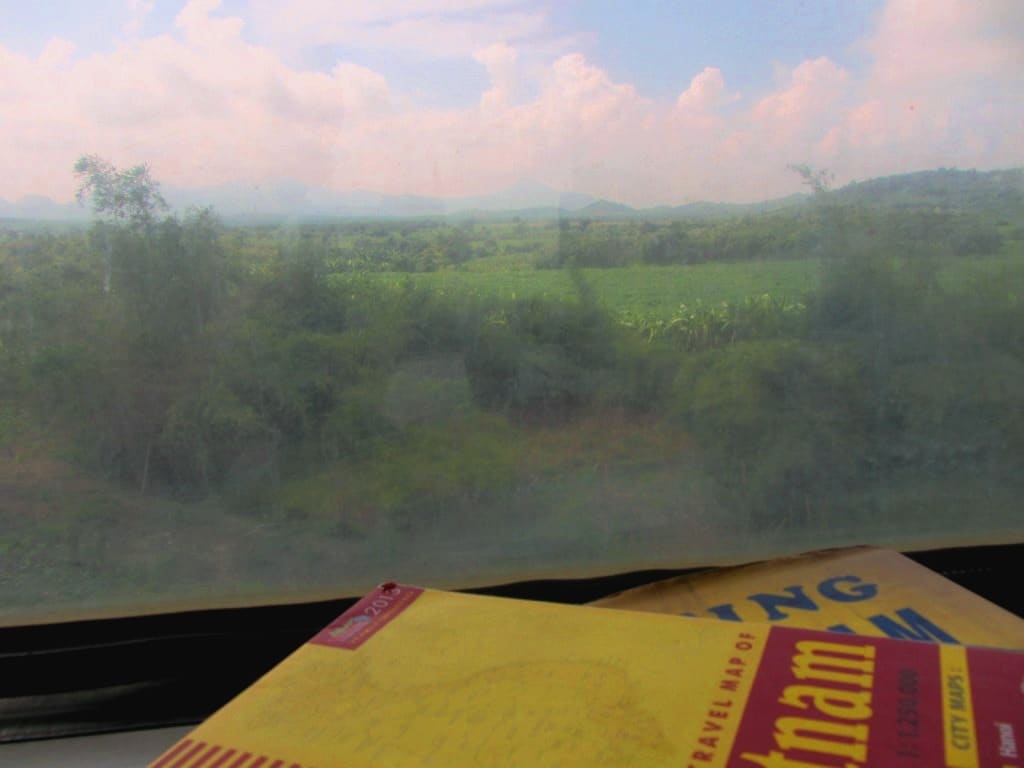
View from the train: lush scenery rolls by the window between Saigon and Phan Thiet
The first time I took this train, I was surprised at how lush and scenic the journey is. Usually, when I travel between Saigon and Phan Thiet, I choose to ride my motorbike along the quiet and scenic Ocean Road. The other alternative, which I do my best to avoid, is to take Highway 1; a horrible, truck-choked ride through an arid landscape, obscured by dust and scarred by concrete dwellings lining the road. The train line follows a similar course to the highway, so I was expecting similar scenery. But, because there is only minimal development surrounding the railway, the landscape is green, fairly clean, and sparsely populated. Never have I approached Phan Thiet from Saigon in such a serene, gentle and relaxed manner as by train. Seasons also determine what the landscape will look like out of your window: the late dry season months of April and May are often arid and parched.
There is a brief stop at Binh Thuan station, from where the train travels along a spur line to Phan Thiet. From here, it’s a short taxi ride to Phan Thiet city – an interesting coastal settlement with some great seafood – or the resort-studded coast of Mui Ne. Or, if you have your motorbike with you, you can hit the scenic Coast Road or head straight up to the Central Highlands on Road QL28 towards Juliet’s Villa and on to Dalat.
*Please support Vietnam Coracle: you can search train times, prices, and make bookings directly from this page by using the Baolau.com search boxes & links throughout this guide. If you make a booking, I receive a small commission. All my earnings go straight back into this website. Thank you.

Disclosure: I never receive payment for anything I write: my content is always free and independent. I’ve written this guide because I want to: I like this train route and I want my readers to know about it. For more details, see my Disclosure & Disclaimer statements here
[Back Top]

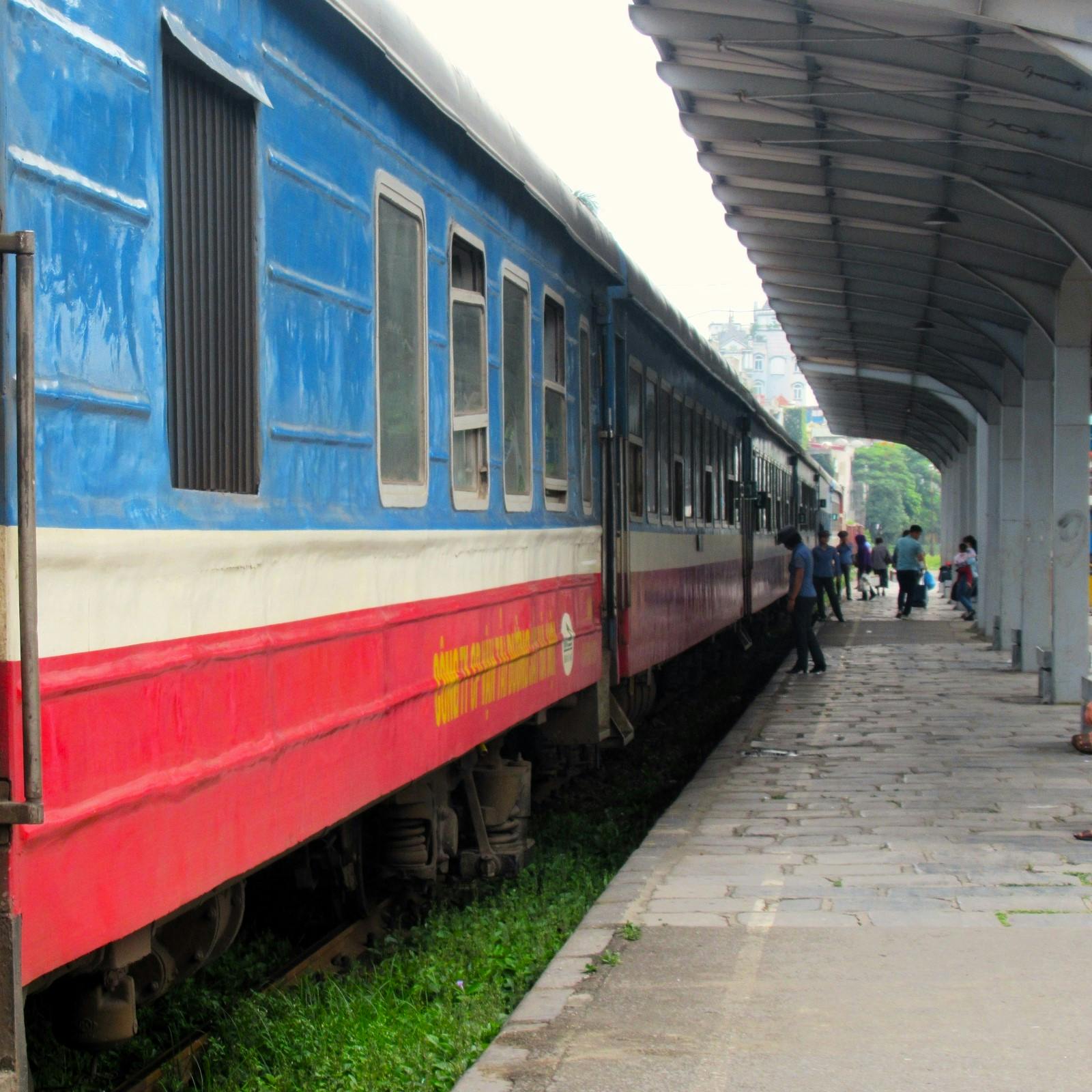

With the reduced Phan Thiet train schedule, the only option outside of Friday and Saturday is the Sài Gòn to Bình Thuận train. Does anyone know if you can load bikes onto this train with you like the Phan Thiet train?
Hi Braden,
Actually, the train schedule for the Saigon > Phan Thiet train changes regularly depending on the season. For example, right now it is operating daily. So double-check the schedule for your dates of travel.
For sending your bike to Binh Thuan station, please see this guide.
Best,
Tom
Hey Tom,
Thanks for the quick reply!
Does VNR only post the schedule a certain period of time ahead? Currently look at 02/18 and it doesn’t seem like the train is running that week except for maybe Fri/Sat
Thanks!
Hi Braden,
If you’re just looking at the schedule for a couple of weeks from now, I would imagine that’s accurate. You can also check the schedule on Baolau.com.
Best,
Tom
Update 12/27/2024
Ga Sài Gòn > Ga Phan Thiết
Service runs Friday and Saturday
6:30am > 10:30am
Load bikes at 6am
Cost including tax:
passenger 238,000
bike 188,000
They still have piping hot sweet corn! 🙂
Love skipping the pollution/heavy industrial belt around the TP HCMC. Thx Tom 👍🏼
Hi Cameron,
Thanks for the current times. It is a shame that the train runs on a reduced schedule during the low-season. However, the frequency should increase to daily during the Tet Lunar New Year and then the summer period.
Best,
Tom
It’s a bit of a catch-22. Not enough people, so they are cutting service, and if it’s so busy, we need reservations. Haha!
I met a solo traveler and shared the train info with them. It’s the most peaceful way to get in and out of HCMC. It took me years and a lot of headaches, but I’m a believer now.
Incidentally, Ocean Dunes is an amazing property. We’re relaxing by the ocean, watching the waves crash as I type. Thx for your reviews.
Thanks. Glad to hear you’re enjoying it.
Tom
ciao Tom,
I would like to know if the Saigon – Binh Thuan train still carries motorcycles
thank you
Hi Stefano,
Yes, the Saigon-Phan Thiet train carries motorbikes.
Best,
Tom
Hi Tom
Quick question as I’m going to be booking tickets for a group. Do you need a lot of details for booking bike tickets (eg: registration, blue card etc)
Also are there any limitations on bike size as we’ll have at least one big boy with us?
Hi Simon,
Firstly, at the moment the train is only running Friday-Sunday. Of course, this could change at any time, particularly with the New Year holiday season approaching. Secondly, if you want to book bike tickets in advance (as opposed to passenger tickets), you will probably need to do it in person at a train station.
Yes, bigger bikes should be OK, although there probably is a limit – a massive BMW might be an issue.
You shouldn’t need the registration numbers or blue cards when you book your bikes on the train, but I suppose it’s good to have those details with you if for some reason they ask.
I hope this helps,
Tom
Cheers Tom. I’m planning ahead for next year when it seems the trains are running again as I’ve booked the seats already. Bikes a Benelli 400 but not much bigger than a Honda PCX or NVX really
Great! I would think that’ll be OK.
Tom
Yesterday I was at Phan Thiet railway station, they did not changed schedule from friday-sunday.
Hi Dusan,
Can you explain a bit more clearly what you mean? Are you saying the train only runs on the weekend?
Best,
Tom
Unfortunately it seems that the Phan Thiet service only runs on weekends now. During the week you can go to Binh Thuan although it’s a bit far out the way.
Any idea the price to take a bicycle on the train?
Thanks.
Hi Chris,
Yes, sorry about that: the reduced schedule is due to fewer people travelling during the pandemic. The train should still run on Friday, Saturday and Sunday.
I don’t know the exact price for a bicycle, but it must be around half the price of a motorbike. So perhaps 100,000vnd.
I hope the journey goes well,
Tom
Hi Tom
Do you know how many days in advance you can buy the bike tickets from Saigon Rail Station? Looking at heading to Mui Ne to start a ride in August but i’m a bit worried about getting the wife up and over to the station and looking for a bike ticket seller so early. I won’t be able to get into that part of the city for a few days before so was wondering if it’s possible to buy the bike ticket a 5 days to a week in advance?
Hi Simon,
I don’t know exactly how far in advance it’s possible to buy tickets for a motorbike on this train route (although you can certainly buy passenger tickets many weeks in advance). However, in the past I have bought my bike ticket 5 days to 1 week in advance by going to the station. You’ll need your bike plate number and model and some ID, of course.
Please also note that until recently, this particular train route was operating on a reduced schedule (Friday, Saturday, Sunday only), but is now back to its usual timetable of once every day of the week.
I hope this helps,
Tom
The frustrating part of this service is the timing. If someone from Saigon wants to spend the weekend in Mui Ne, then they want to get on the train at about 5pm, not lunchtime.
Hi Chris,
Actually, I think it works out really well: the train back to Saigon always leaves around 1pm which is an hour after check-out time at almost all hotels, so that’s good timing, and then the train arrives back in Saigon around 5.30pm just before it gets dark. Pretty good.
Tom
Great to find out about this one!
I mentioned on another page (the Phu Quoc Island page) that I’m planning a grand North-South ride from Mong Cai to Phu Quoc, which is now just next month! After your recommendations for the coast roads between Mui Ne and Nha Trang I had been agonising over whether to stick with my original plan of going via Dalat. Having read this, I can now work out a way of doing both (since I’m now going to be returning to my current workplace in Dong Ha afterwards), by sticking with the Dalat itinerary on the way south, then riding back from Phu Quoc to HCMC; then put my bike on this train and ride off and up the coast; then load the bike at Nha Trang to go back to Dong Ha.
Also read about the Hanoi-Hai Phong train also carrying motorbikes with passengers and am now going to use that to help me get to my start point as well. Thanks for all the useful information!
Looking forward to it!
Hi Keir,
That’s good to hear – sounds like a solid itinerary.
Remember, for the coastal stretch north of Phan Thiet and Mui Ne on the ‘Sand Dune Highway’ take the red route outlined on the map in this guide in order to avoid the police.
I hope this helps,
Tom
Hi Tom
Booked a train ticket to take me back into Saigon following Tet (still in the public holiday so very lucky to grab a remaining seat).
I was wondering if you know if they will have the bike carriage in use at Tet, a bit worried that they won’t to add more seats. I’m having a day in Mui Ne before setting off home on the 29th so i’ve got time to check but thought i’d ask. If I can’t get on i’ll get up early that day and ride home but would be nice to put my feet up for the day on the packed train instead!
Hi Rob,
Good idea to book your ticket already.
Yes, they should still be operating the bike carriage during Tet, but as with all things at that time of year, there will be pressure on space, so the sooner you can book a space for your bike the better. But, as you say, if you find they’re full, you can always ride back instead – I’ve had that experience a couple of times myself too.
Tom
Hi Tom,
Thanks a bunch! Love reading your adventures. I just have a question regarding soft seat and premium; regardless of price, which is better?
Hi Timothy,
Premium usually has colder air-con and electric sockets, but actually I prefer the normal soft seat because it’s not as crowded and a reasonable temperature. Either way, there’s not that much difference between the two 🙂
Tom
Hi, Tom.
Mirroring all the comments here that your site is beyond helpful for planning a trip to Vietnam. Thank you for all the time spent sharing so much! A lot of work, I’m sure.
My son and I are flying into HCM during the beginning of January and, after spending 3-5 days in Saigon, will rent bikes to put on the train to Phan Thiet. My question for you is how much time should we plan to comfortably travel to Hoi An/Danag via motorbike from Phan Thiet? We plan to take the coastal route and head inland if there are any places of interest. We’ll likely fly to Hanoi from Hoi An/Danag and perhaps rent bikes (or to a tour) in the mountains. We’ve heard it’s pretty cold that time of year, but we’re from Chicago, so thinking it won’t be too bad.
Thanks & regards,
Ezio
Hi Ezio,
Yes, it probably will be a bit cold in the mountains in the north at that time of year, but, as you say, nothing like the winters you get in Chicago. In general, people still enjoy their road trips in the north at that time of year, so there’s no reason not to do it: just remember to pack some warm clothes.
It’s very difficult to estimate travel time, because it depends on how you ride, how much you stop, the weather conditions, and the route. But anywhere between one week to 10 days is pretty comfortable for Phan Thiet to Hoi An if you take it leisurely and want to stop here and there. Riders with experience in Vietnam and who don’t stop much can do it in as little as 3-4 days, but there’s not much sightseeing involved when you do it that quickly.
I hope this helps,
Tom
Hi Tom, as always, thank you for your invaluable posts.
Just to feedback to the community: I’m currently in Phan Thiet, and if you want to buy tickets online for Phan Thiet- Saigon you need to do so at least 18hrs before, afterwards it looks like the train is full but it isn’t necessarily so, it’s just online tickets are no longer available for logistical reasons I guess. I went to the Phan Thiet station early this morning for same day tickets for me and my bike, it’s an adorable station, opens super early, and the attendant was able to help me in basic but helpful English.
Soft seat ticket to Saigon was 150000 dong. My bike ticket was 170000. All very easy to do. There is a long almost straight street/alley leading from the “water-port” area to the station. Starting from the station it is called Lê Duẩn and it becomes Cao Thắng. The whole town has no shortage of places to eat and drink coffee but I found this whole stretch particularly endearing. Also, along the water at Lê Lợi street there’s a nice outdoor seated area with many vendors in the morning serving all types of food/drinks.
All in all I found Phan Thiet a great town, definitely worth exploring, getting off main large roads and settling in for a few days to get a sense of what a small and vibrant city feels like. Getting up early in the morning helps too:-)
Hi Noemi,
Thanks for the information. Yes, I think that’s right, but it might also have something to do with this being the summer holidays for Vietnamese, and thus one of the busiest times of year for this train route. In fact, sometimes they have two trains leaving at the same time to accommodate all the extra passengers. I think that outside of the summer and New Year holidays, you should be able to book tickets online, even at short notice, although it’s still wise to book in advance. And, as you say, buying tickets at Phan Thiet station is quick and easy.
Tom
Ps: the streets I mentioned were pretty deserted at noon, so the recommendation is only for early morning (and probably end of afternoon when vendors comes back)
Also, you were right Tom, the train was full. And last, thanks a million for the recommendation about the restaurant wagon, I had a brilliant time there, food was good (great sauted beef & vegetables), loved the corn, and the perfect way to enjoy the train ride.
Noemi,
Glad you enjoyed it!
Tom
Hey Tom! 🙂
Just wondering if you could ride from Saigon to Mui Ne in one day? (Leaving Saigon at 430am). Or would it be better to stop somewhere mid way?
The following are places we want to stop at on our beach bum trip…
How long or how many k’s are the following (along the coast)
Trying to work out how much riding per day we are going to need to average 🙂
Mui Ne to Quy Nhon
Quy Nhon to Hoi An
Hoi An to Hue
Hue to Phong Nha
Phong Nha to Ninh Binh
Ninh Bing to Hanoi
We are no longer duing Mui Ne. So instead we will drive from Da Lat and head to Quy Nhon. I know this looks like too far to cover in a day. So we will aim to sleep somewhere after Nha Trang (I’m not too interested in stopping in Nha Trang for a night)
Hi Anna,
You could stop at Dai Lanh Beach, for example.
Tom
Hi Anna,
If you’re planning to stay on the routes that I suggest on this website to get between the places you mention then some of those days are too long. For example, Quy Nhon to Hoi An via the coastal route (avoiding Highway 1 as much as possible) is a long day, especially if you’re not used to riding in Vietnam. Also, Phong Nha to Ninh Binh is a very long distance to cover in one day. (Check sections 6-8 of this guide for possible places to break that journey). Hoi An to Hue (check this guide), and Ninh Binh to Hanoi are both fine.
Bear in mind that all my guides try to take the most scenic routes between places, avoiding busy main roads as much as possible. If you want you can take more direct routes to cut down time and distance, however you’re experience of Vietnam’s roads and landscapes will not be as rewarding if you take the direct routes along the horrible highways.
I hope this helps,
Tom
Thanks Tom,
Super helpful! Coastal route looks good for us! Any recommendations for places to stay between Quy Nhon and Hoi An?
Hi Anna,
You can break the journey between Quy Nhon and Hoi An by staying at Sa Huynh beach, or Quang Ngai city, of My Khe beach (just east of Quang Ngai) or Tam Ky.
Tom
hi,
just an update, as of today (january 7th, 2017), the prices are: motorbike 170,000 vnd and passenger 186,000 vnd. For phan tiet, there is NO need to drain the gas tank, this is required for Saigon to Nha trang though.
two trains daily each direction:
SPT2: leaves saigon at 6:40am arrives Phan Thiet at 10:26am
SPT4: leaves saigon 6:30pm arrives PT at 10:26pm
SPT1: leaves PT at 1:10pm arrives Saigon at 5:14PM
SPT3: leaves PT at 11:55 PM arrives Saigon at 4:07pm
Hi Kiki,
Thanks for the information. But are you sure about the two trains a day in each direction? I took this journey just a couple of weeks ago and, although the schedule says there are two trains in each direction, when I asked the staff at Saigon ticketing office, they told me that there is only one train. Apparently, they started the additional journeys but, due to bad ticket sales, they stopped it again. Also, if there are two trains a day now, perhaps that is just to accommodate the extra flow of people during the Tet rush.
Thanks,
Tom
tom,
this was printed on a signboard on the sales counter at the saigon train station. i will ask specifically for tbese trains when i will travel next week.
Tom,
I stand corrected, your schedule is correct. In both railroad station they display two trains a day but in general only one is running every day.
Also i wasn’t
asked for a “handling fee” when storing my bike in tbe train … lucky me.
Hi Kiki,
Thanks for confirming that. It’s a shame, because an evening train from Saigon to Phan Thiet would be very convenient. Oh well, maybe they’ll start the extended schedule again someday.
Glad to hear you didn’t have to pay a handling fee 🙂
Tom